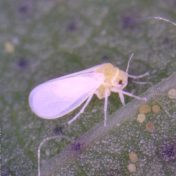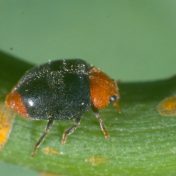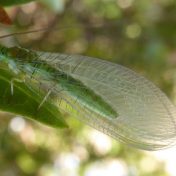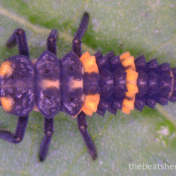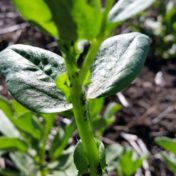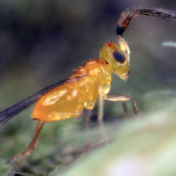As part of the cotton industry’s proactive approach to managing resistance risks, there is an ongoing program of resistance surveillance in the major pest species. Resistance to spirotetramat (Movento®) was first detected in silverleaf whitefly (SLW) in the Burdekin region in 2016. From 2016–2024, 131 SLW populations have been collected and tested for resistance to spirotetramat, 4 populations were from… Read more »
Cryptolaemus montrouzieri is a ladybird beetle native to Australia that feeds predominately on mealybug and soft scale insects. Identified as an effective biological control agent, it has been exported to many other regions, and is reared commercially for control of a range of mealybug species, particularly in horticultural crops. In cotton crops where solenopsis mealybug (Phenacoccus solenopsis) is present, Cryptolaemus… Read more »
Green lacewing larvae are generalist predators, and are important natural enemies of a range of pests including aphids, helicoverpa, whitefly and mealybugs. There are many species of green lacewings in Australia, including some that commonly occur in field crops. Readers are most likely to be familiar with Mallada signatus, which regularly features in ID guides, but another species, Plesiochyrsa ramburi… Read more »
Adult ladybird beetles are one of the most easily recognisable natural enemies in cropping systems. Both adults and larvae are voracious predators, and can have a considerable impact on pest populations, particularly aphids. Several species of ladybird beetles are commonly encountered each year in grain, pulse and cotton crops. Ladybirds are often attracted into crops by the presence of aphids,… Read more »
Of importance to agronomists is how pest populations are changing over time and the likely impact predators will have on the pest population. Predator and parasitoid activity can be difficult to assess under field conditions, particularly the rate at which beneficials can find pest species. In this research, sentinel prey were used to gauge the level of natural predator and… Read more »
The tiny wasp Eretmocerus hayati is an important natural enemy of silverleaf whitefly (SLW) and contributes to the natural biological control of this pest throughout the season. It occurs in almost all regions that grow cotton, but due to its small size (difficult to see without a hand lens) it often goes unnoticed. Like all natural enemies, Eretmocerus is susceptible… Read more »
With the current season shaping up to be one of high insect pressure, we may see silverleaf whitefly (SLW), Bemisia tabaci reach problematic levels in regions outside of their traditional range. For growers and agronomists not familiar with their control it is worth investing some time to understand how one of the main registered insecticides, pyriproxyfen, works. What is pyriproxyfen?… Read more »
The minute two-spotted ladybird beetle (Diomus notescens) and the transverse ladybird beetle (Coccinella transversalis) are two natural enemies of cotton aphid (Aphid gossypii). They are commonly found in Australian crops, however relatively little is known about their biology. A series of laboratory experiments were conducted by the Queensland Department of Agriculture and Fisheries (DAF) to learn more about aspects of… Read more »
Two new insecticides have recently been registered to control Bemisia tabaci B-biotype in cotton. Product Insecticide group Active ingredient Pest Exirel® anthranilic diamide (Group 28) cyantraniliprole SLW, Helicoverpa, cotton aphid (suppression only) Starkle® neonicotinoid (Group 4A) dinotefuran SLW & green mirid Exirel® was registered for cotton use in the 2013/14 season, and Starkle® has been registered for the current cotton… Read more »
